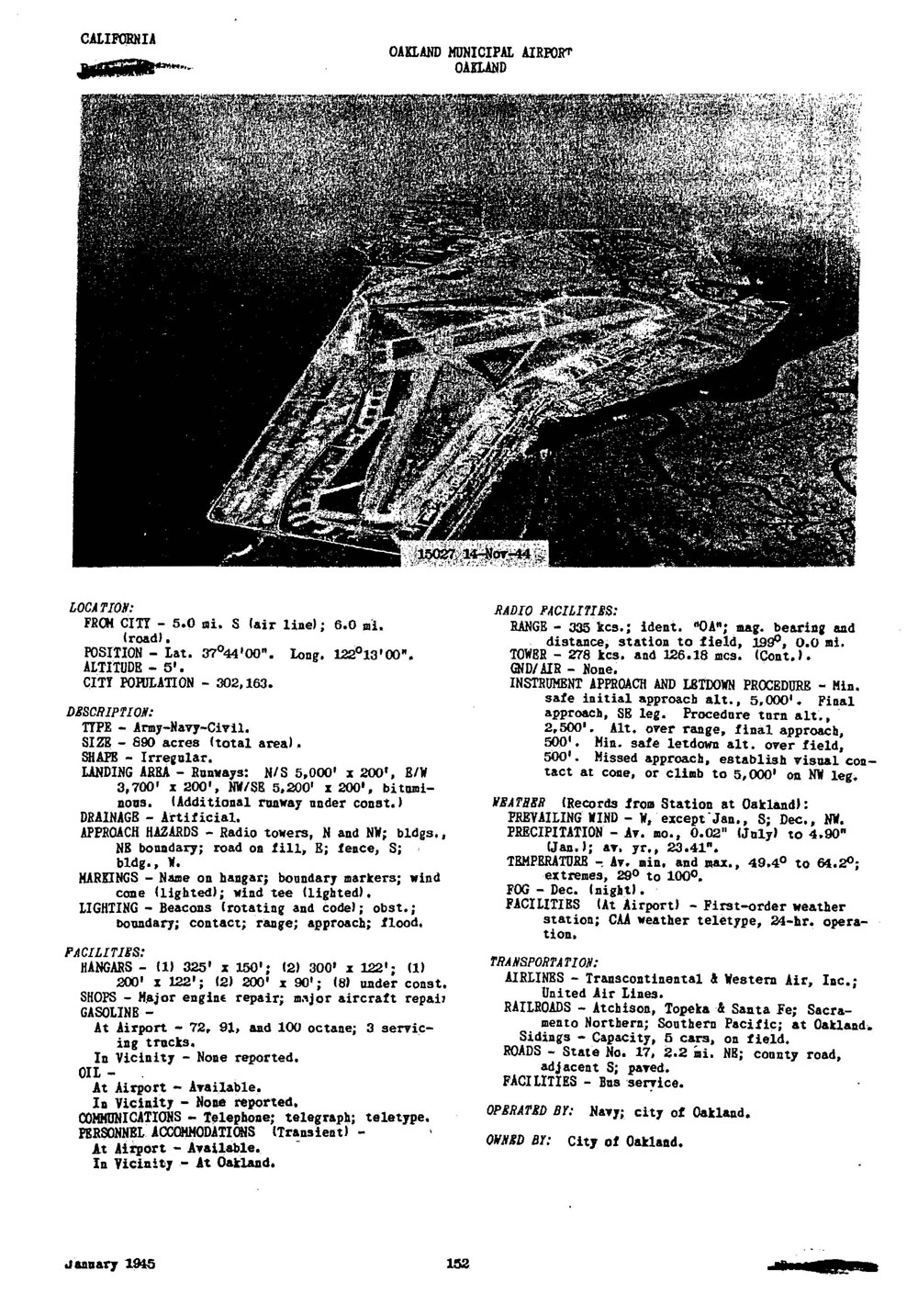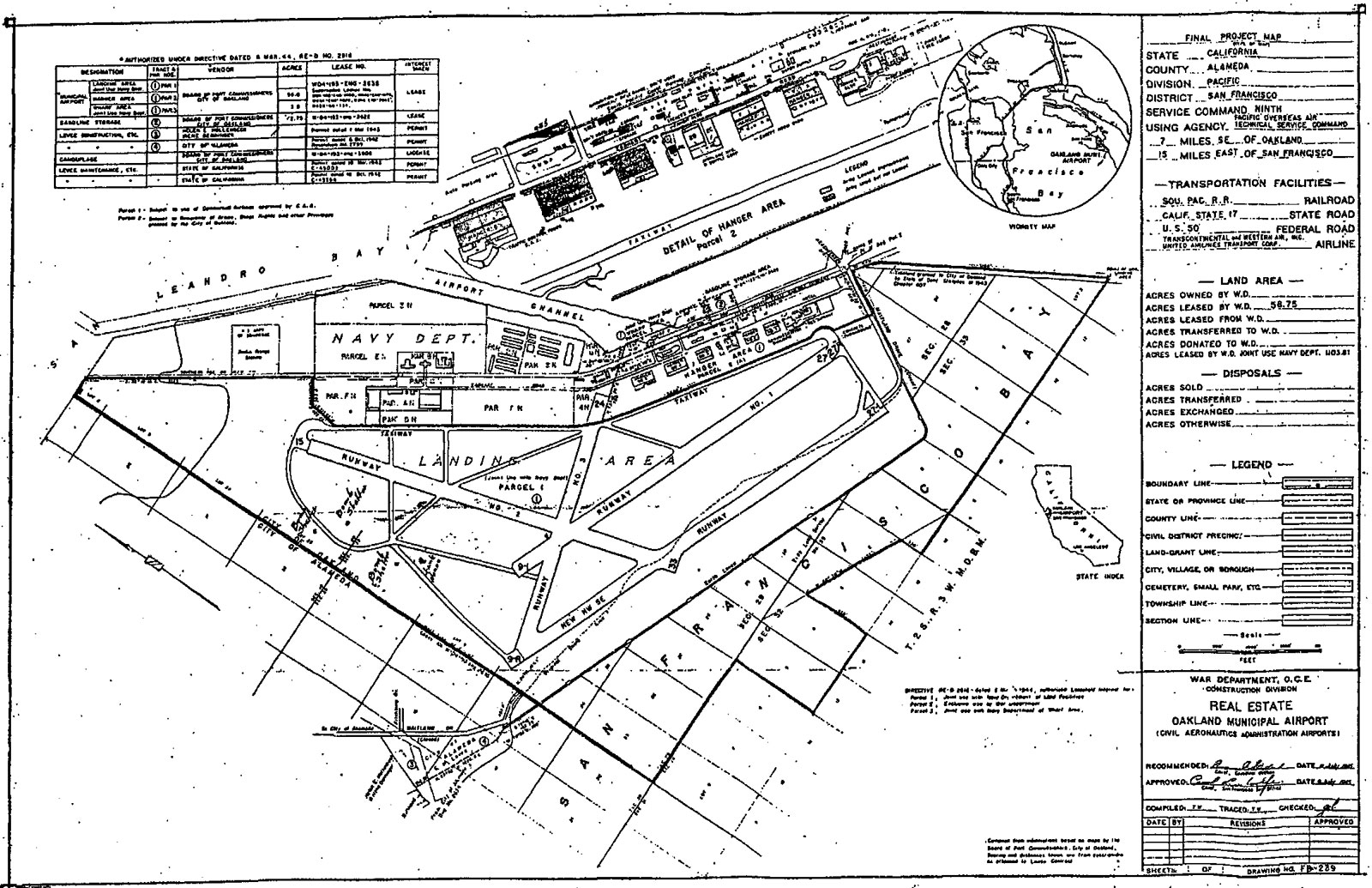
On February 5, 1927, the Oakland City Council purchased the 692-acre Bay Farm Island, five miles south of town, to develop an airport. On June 3, the Army informed the City that it wished to use the island as the takeoff point for an attempt to fly to Hawaii. Since a runway did not yet exist, the Army requested that one be graded by the end of the month. Working around the clock for 23 days, crews completed a 7,020-ft. runway -- at that time, the longest in the world. On June 28, 1Lts. Lester Maitland and Albert Hegenberger departed in a Fokker C-2. Twenty five hours and 49 minutes later, they landed on Oahu at the Army's Wheeler Field, completing the first non-stop flight between the Mainland and Hawaii.
On August 1, 1928, the Navy formed an NRAB at the airport with two aircraft and 1200 sq. ft. of leased hangar space. By 1935, the station began the Elimination Training Course with ten aircraft. Eleven days after Pearl Harbor, the C.O.s of all the NRABs held a conference in Pensacola -- the subject being the increase of primary training at their bases. Among the C.O.s with a problem, was Cdr. R.L. Johnson of Oakland. With the addition of Army interceptors at the airport, the expansion of primary training would be impossible without a new base. After returning to Oakland, Cdr. Johnson and his men selected a site 25 miles away, 3.5 miles east of Livermore. Nevertheless, full primary training began in January 1942. With the imminent departure of primary training, Oakland was chosen to be a Naval Air Transport Service Terminal. In September, VR-3 began scheduled service to the station. By November 1942, all primary flight activities transferred to Livermore; however, administrative control remained at Oakland.
On January 1, 1943, Oakland became an NAS along with most of the other NRABs in the Navy. On March 4, VR-4 commissioned with a complement of 13 R4Ds received from Alameda's VR-2 which then became an exclusive seaplane operation. When Livermore commissioned as an NAS on June 1, Oakland was, in turn, reduced to an NAAS under Alameda. VR-11 commissioned here on September 1. Although the headquarters of VR-11 moved to Honolulu three and a half months later, the squadron maintained a detachment and conducted training at Oakland. Meanwhile, United Airlines had an aircraft mechanics school for the Army at the airport. In 1943, United began training Navy mechanics and completed 1,281 during the war.
The military began using the Oakland Municipal Airport (OMA) as early as 1927 (the year it was established) on an occasional basis as a starting point for long distance Pacific flights. The first stationing of Army aircraft at OMA on a regular basis appears to have occurred with the organization of the 9th Corps Area Air Corps Detachment on 19 June 1936. The main mission of the detachment was flight training of Air Corps Reserve Officers of the Northern California Military District along with servicing transient aircraft. These activities continued through at least 1941, by which time the flight training included 2 hours of ground target gunnery and 4 hours of aerial target gunnery, though the location for this training was not noted.''
In August 1940, the Army Air Forces contracted with the civilian Boeing School of Aeronautics already in operation at OMA to train their airplane mechanics. The station was activated on 20 September 1940 as the Air Corps Training Detachment, Boeing School of Aeronautics, Oakland California. Two years later, all commercial activities at the school were discontinued. A little over a year after that, in November 1943, the Army's contract for the training ended, but not before the Navy established a detachment for their own mechanics there.
With the start of the war, the 4' Air Force, headquartered at Hamilton Field about 30 miles to the northwest across San Pablo Bay, began dispersing interceptor aircraft around northern California. Dispersal bases included Oakland, which became the headquarters of the 4th Air Force Fighter Command. Accordingly, with an expanded presence at OMA, the Army made improvements to the airport runways and increased the facilities.
In June 1942, the planned increase in facilities at the dispersed airdrome included additional taxiways, housing and bomb storage facilities. An indoor Rifle Range (Building Number 26) already existed by that time. The housing plan included acquisition of a detached 14.59-acre parcel for a housing/cantonment area.'' Also during 1942, the Army completed 5 buildings for Battery "G" of the 217th Coast Artillery Regiment (Anti-Aircraft) at OMA. The Anti-Aircraft weapons of the 217th are unknown, but most likely consisted of 37mm and 50 caliber antiaircraft guns. The location of the weapons assigned to Battery G are unknown, but probably included emplacements in and around the airport.
By March 1944, the 4th Air Force planned on transferring jurisdiction of OMA to the Air Service Command (ASC), retaining use of airfield for emergency tactical operations only. On 1April, the Army portion of OMA fell under the command of the Sacramento ASC to be followed by a transfer to the Pacific Overseas ASC on 15 August 1944. At this time, the pllnciple activity at OMA was the processing of combat aircraft for overseas shipment to various theatres of operation.
Following the end of the war in the fall of 1945, the civilian Port of Oakland that operated OMA officially requested the relinquishment of the Amy's facilities, so that commercial operations might resume as soon as possible. Although the Army Air Forces had not determined their future requirements for OMA, they had no objection to the use of the facility for civilian and commercial activities. The War Department declared the separate cantonment area surplus by that December, and the leases for several small parcels were canceled in early 1946. However, the Army's declaration of excess did not occur until September 1946 and the accountability for the main airfield was not transferred to the War Assets Administration until 19 December 1947. Subsequently, the Port of Oakland regained control of the Army's portion of the property.
General Site History-Navy
The Navy's continued presence at Oakland both predates and continues long after the Army Air Forces. On 1 August 1928, the Navy formed a Naval Reserve Air Base (NRAB) at OMA. By 1935 the NRAB began an elimination training course. At the beginning of the war, in Januay 1942, the NRAB Oakland began full primary training of Navy fliers in the Bay area. However, the dispersal of Army interceptors at OMA crowded the airfield too much for use as a primary flight instruction facility. The Navy selected Livermore as the new location for primary training, and moved the activities there by that November. Assembly and repair functions and administrative control remained at OMA. Approximately a dozen auxiliary fields were associated with this primary training mission that initially fell beneath Oakland, which all later became associated with Livermore.
On 1 January 1943, the Navy's portion of OMA became Naval Air Station (NAS) Oakland, in a general upgrade of all the NRABs in the Navy at the time. Its status was reduced to a Naval Auxiliary Air Station (NAAS) on 1 June with the commissioning of NAS Livermore. Although the primary flight training moved, the Navy's presence continued at OMA as a Naval Air Transport Service (NATS) terminal. NATS established its West Coast headquarters at NAAS Oakland, which continued as an operating, maintenance and overhaul base, and a school site for mechanics. Following the establishment of the overall NATS headquarters at OMA, the base was once again upgraded to an NAS on 1 May 1945. Following the end of the war, the Navy planned on placing NAS Oakland in reduced operational or caretaker status. The date kept moving back from fall 1945 to fall 1946, as preparations to move the NATS mission across the bay to Moffit Field were delayed by facility construction.
Effective 1 October 1946, NAS Oakland was placed on reduced status. Subsequently, the Navy reestablished a reserve air station at OMA, which continued operations there until 1961. At that time, NAS Oakland closed and the reserve mission moved to NAS Alameda, thus ending direct military use of the site.


